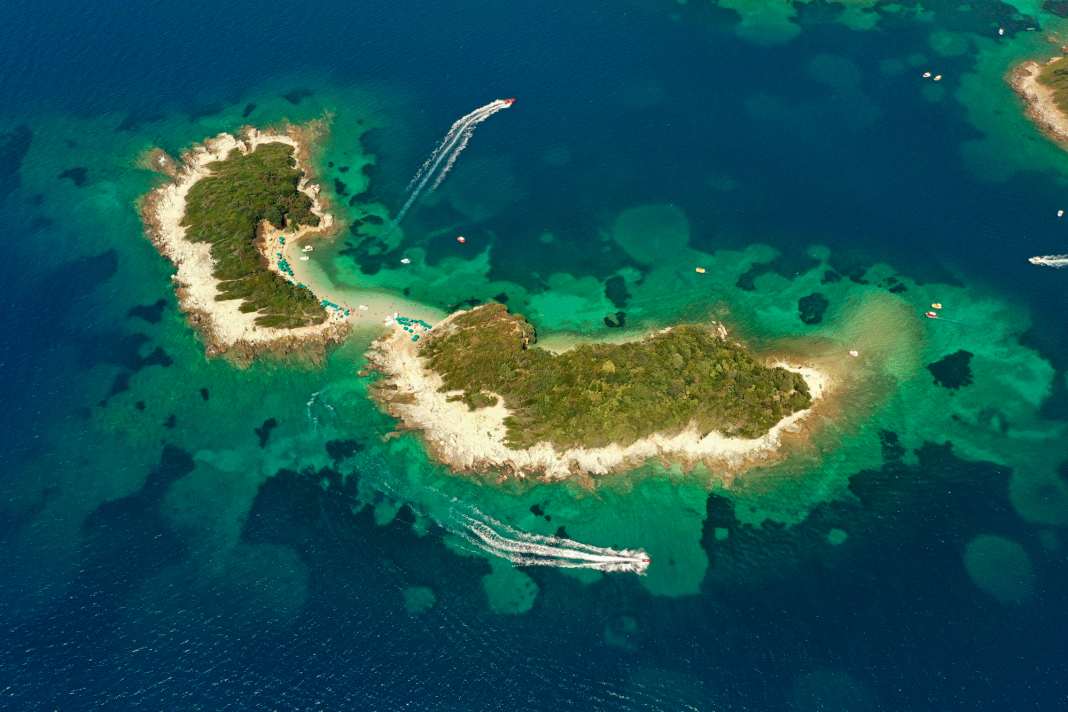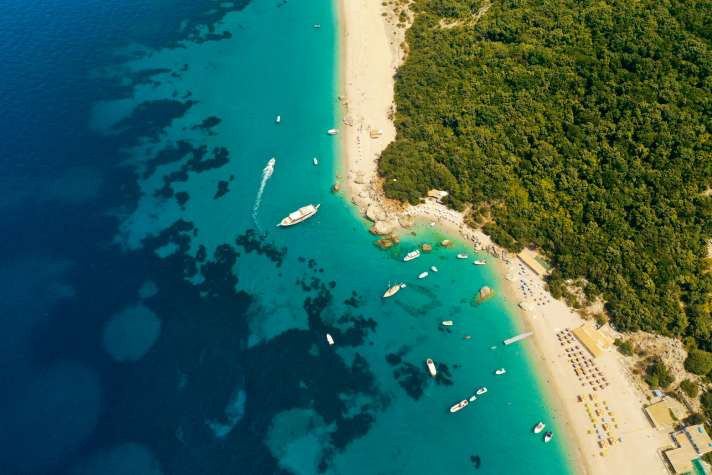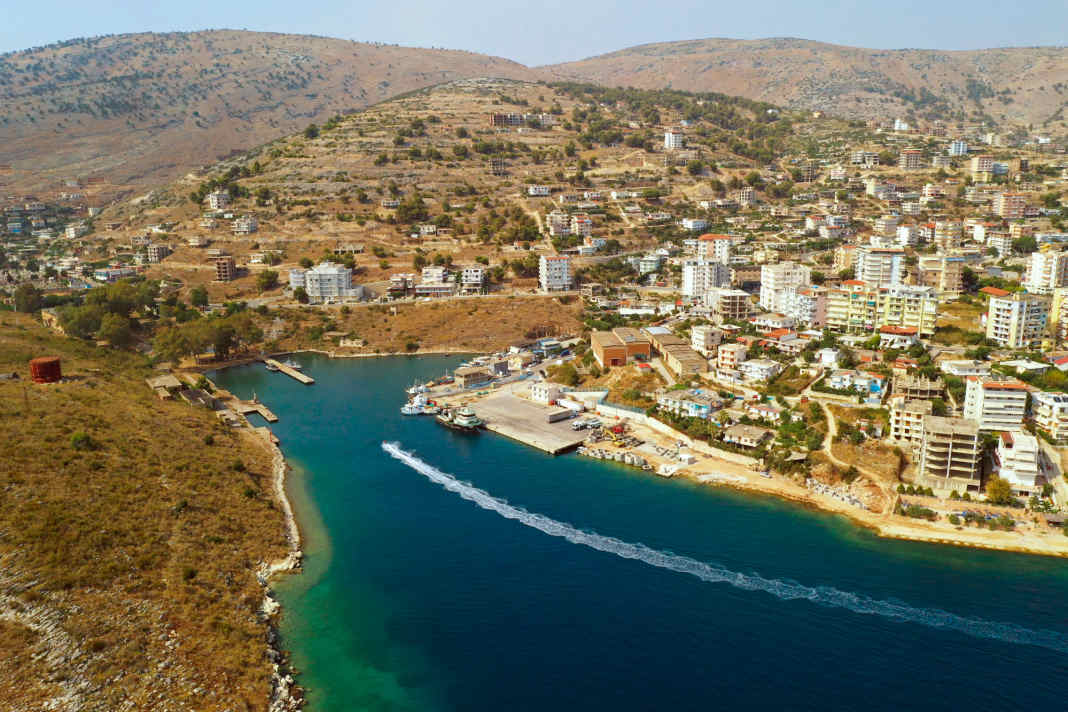


Only a few foreign boaters ever saw the Albanian coast. Until the fall of the communist dictatorship in 1990, it was forbidden to enter the heavily segregated country in a pleasure craft. After the political change in 1991, however, many things changed. Albania finally joined NATO in 2009 and became an EU accession candidate in 2014. From then on, foreign yachts were welcome, but were only allowed to moor in commercial harbours and had to clear in and out bureaucratically, even when continuing their journey within the country. The beauty of the coast and the paradisiacal anchorages remained hidden from foreign boaters. This also applied to Albanians, who were forbidden to sail along their own coast in pleasure craft.
Everything has been different since November 2020. A new law now allows Albanians to own pleasure boats and sail on their own coastline. Foreign yacht crews only need to clear in once when entering the country and can then move freely around the country and anchor in bays. The new laws have already triggered a boom for the 2021 season. Financially well-heeled Albanians are buying jet skis and heavily motorised RIBs, and now also sailing and motor yachts. The first Albanian charter company is also already on the market. There is only a lack of marinas. In spring 2021, the licences for nine marinas, which are to be built along the entire coast, were auctioned off.
Apart from the Marina di Orikum, built in 2005 by an Italian company in the Gulf of Vlorë, the nautical infrastructure in Albania is still sparse. However, it is definitely worth discovering the fascinating southern coast of Albania with its bays. Here, for the first time, we show you the most beautiful places on the Albanian Riviera from Porto Palermo southwards to the border with Greece.
![| Reproduction only with fee, attribution and voucher copy; fee according to the current fee recommendations of the Mittelstandsgemeinschaft Foto-Marketing (MFM), unless otherwise agreed before use. Bodo Mueller, Mecklenburger Landstr.56, D-23570 Travemuende Tel. 04502/ 2669, e-mail: info@bodo-mueller.de; www.bodo-mueller.de Taxable with 7 % VAT at the Luebeck tax office, tax no. 2215760072. Bank details: Postbank Hamburg BLZ: 20010020 Account no. 546078-202, IBAN DE65 2001 0020 0546 0782 02 BIC PBNKDEFF]](https://media.delius-klasing.de/dk-wassersport/images/dpr_auto,fl_progressive,f_auto,c_fill,h_475,w_712/q_auto:eco/boot/14DJI_0810_0b7e96f4eb9858b70c21f3f657241971/-reproduction-only-with-fee-attribution-and-voucher-copy-fee-according-to-the-current-fee-recommendations-of-the-mittelstandsgemeinschaft-foto-marketing-mfm-unless-otherwise-agreed-before-use-bodo-mueller-mecklenburger-landstr-56-d-23570-travemuende-tel-04502-2669-e-mail-info-bodo-mueller-de-www-bodo-mueller-de-taxable-with-7-vat-at-the-luebeck-tax-office-tax-no-2215760072-bank-details-postbank-hamburg-blz-20010020-account-no-546078-202-iban-de65-2001-0020-0546-0782-02-bic-pbnkdeff-)
1 Porto Palermo
The large natural harbour is a place steeped in history. The Venetians built a fort on the peninsula in the bay, which has a narrow land bridge to the mainland. Around 1800, Ali Pasha Tepelana, an Ottoman pasha of Albanian descent, developed the peninsula into a fortress. Ali Pasha endeavoured to secede Albania from the Ottoman Empire. In communist Albania, the Soviet Union stationed twelve Whiskey-class submarines in Porto Palermo. After the break with the Soviet Union in 1961, the Albanian dictator Enver Hoxha demanded the withdrawal of the Soviets, but captured four submarines that had been travelling with Albanian crews. To hide them, he built a 650 metre-long submarine tunnel through the northern peninsula of Porto Palermo. This part is now NATO territory. Yachts are allowed to moor at the former military jetty between the peninsula and the mainland. Ali Pasha's fortress can be visited.
![| Reproduction only with fee, attribution and voucher copy; fee according to the current fee recommendations of the Mittelstandsgemeinschaft Foto-Marketing (MFM), unless otherwise agreed before use. Bodo Mueller, Mecklenburger Landstr.56, D-23570 Travemuende Tel. 04502/ 2669, e-mail: info@bodo-mueller.de; www.bodo-mueller.de Taxable with 7 % VAT at the Luebeck tax office, tax no. 2215760072. Bank details: Postbank Hamburg BLZ: 20010020 Account no. 546078-202, IBAN DE65 2001 0020 0546 0782 02 BIC PBNKDEFF]](https://media.delius-klasing.de/dk-wassersport/images/dpr_auto,fl_progressive,f_auto,c_fill,h_475,w_712/q_auto:eco/boot/15DJI_0198_b05bd4b1970b963f1041deedcefbd16b/-reproduction-only-with-fee-attribution-and-voucher-copy-fee-according-to-the-current-fee-recommendations-of-the-mittelstandsgemeinschaft-foto-marketing-mfm-unless-otherwise-agreed-before-use-bodo-mueller-mecklenburger-landstr-56-d-23570-travemuende-tel-04502-2669-e-mail-info-bodo-mueller-de-www-bodo-mueller-de-taxable-with-7-vat-at-the-luebeck-tax-office-tax-no-2215760072-bank-details-postbank-hamburg-blz-20010020-account-no-546078-202-iban-de65-2001-0020-0546-0782-02-bic-pbnkdeff-)
2 Qeparo
One and a half nautical miles east of Porto Palermo lies the seaside resort of Qeparo with several hotels and a well-developed infrastructure. The bay is well protected and you can anchor at around five metres or moor at a mooring buoy. A special feature of this coast is the "hot bora". It is similar to the Croatian bora, but in Qeparo the gusts, which can reach 6 Bft in summer, are not cold but hot. There are several bars and restaurants on the beach.

3 Krorëz
Popular anchorage in front of a fine pebble beach at 39°56′ N. The approximately one kilometre long beach is divided by a group of rocks. There is a beach bar in the northern part in summer and two restaurants in the southern part. It is 250 metres from the beach to the former Krorëz monastery from the 16th century. Yachts anchor at a depth of four to six metres. The anchorage is relatively open, so it is only suitable in stable weather.

4 Bay of Kakome
The well-protected bay lies half a nautical mile south of Krorëz. Yachts anchor at a depth of around ten metres and moor to the rocks or the pier at the head of the bay. The Manastiri i Shën Mërisë (Monastery of the Virgin Mary) is a kilometre's walk from the beach. It is one of the oldest early Christian monuments in present-day Albania. During the Second World War, the church was destroyed by firebombs from the German Luftwaffe, but was then largely rebuilt true to the original.
![| Reproduction only with fee, attribution and voucher copy; fee according to the current fee recommendations of the Mittelstandsgemeinschaft Foto-Marketing (MFM), unless otherwise agreed before use. Bodo Mueller, Mecklenburger Landstr.56, D-23570 Travemuende Tel. 04502/ 2669, e-mail: info@bodo-mueller.de; www.bodo-mueller.de Taxable with 7 % VAT at the Luebeck tax office, tax no. 2215760072. Bank details: Postbank Hamburg BLZ: 20010020 Account no. 546078-202, IBAN DE65 2001 0020 0546 0782 02 BIC PBNKDEFF]](https://media.delius-klasing.de/dk-wassersport/images/dpr_auto,fl_progressive,f_auto,c_fill,h_475,w_712/q_auto:eco/boot/18_3BM0853_5bdea9e7e4bceb0f93a0ae2951db0eb3/-reproduction-only-with-fee-attribution-and-voucher-copy-fee-according-to-the-current-fee-recommendations-of-the-mittelstandsgemeinschaft-foto-marketing-mfm-unless-otherwise-agreed-before-use-bodo-mueller-mecklenburger-landstr-56-d-23570-travemuende-tel-04502-2669-e-mail-info-bodo-mueller-de-www-bodo-mueller-de-taxable-with-7-vat-at-the-luebeck-tax-office-tax-no-2215760072-bank-details-postbank-hamburg-blz-20010020-account-no-546078-202-iban-de65-2001-0020-0546-0782-02-bic-pbnkdeff-)
5 Gremina
Favourite day anchorage in front of the "folded" limestone rocks below Cape Kefali. Protection from northerly winds, no protection in westerly winds or swell. Caution: many boulders near the shore.



6 Porto Limnionas
Fishing harbour on the western outskirts of Sarandë, where you can also embark and disembark. Diesel petrol station. Supermarket nearby. Registration via VHF channel 11 or 16.

7Sarandë
Economic and cultural centre in the south of Albania. To the west of the harbour bay is the customs pier (ferry port), where yachts can also clear in and out and get a berth for several days. Registration via VHF channel 11 or 16. Sarandë's harbour promenade is lined with an endless number of bars and pubs. Oriental-style life pulsates here in the evenings.
![| Reproduction only with fee, attribution and voucher copy; fee according to the current fee recommendations of the Mittelstandsgemeinschaft Foto-Marketing (MFM), unless otherwise agreed before use. Bodo Mueller, Mecklenburger Landstr.56, D-23570 Travemuende Tel. 04502/ 2669, e-mail: info@bodo-mueller.de; www.bodo-mueller.de Taxable with 7 % VAT at the Luebeck tax office, tax no. 2215760072. Bank details: Postbank Hamburg BLZ: 20010020 Account no. 546078-202, IBAN DE65 2001 0020 0546 0782 02 BIC PBNKDEFF]](https://media.delius-klasing.de/dk-wassersport/images/dpr_auto,fl_progressive,f_auto,c_fill,h_475,w_712/q_auto:eco/boot/21DJI_0703_7371bed83cfe468c01f493d595f22698/-reproduction-only-with-fee-attribution-and-voucher-copy-fee-according-to-the-current-fee-recommendations-of-the-mittelstandsgemeinschaft-foto-marketing-mfm-unless-otherwise-agreed-before-use-bodo-mueller-mecklenburger-landstr-56-d-23570-travemuende-tel-04502-2669-e-mail-info-bodo-mueller-de-www-bodo-mueller-de-taxable-with-7-vat-at-the-luebeck-tax-office-tax-no-2215760072-bank-details-postbank-hamburg-blz-20010020-account-no-546078-202-iban-de65-2001-0020-0546-0782-02-bic-pbnkdeff-)
8 Ksamil
Popular seaside resort on the Strait of Corfu, about 6 nm south of Sarandë. There are plenty of places to anchor between the four Ksamil islands. Anyone mooring here in the early or late season will be delighted with Ksamil (approx. 8000 inhabitants). There are numerous beaches and an endless number of pubs and bars by the water. Woe betide anyone who anchors here in July or August. Then you won't be able to get a standing place on the beaches, every bar tries to outdo the neighbouring one in terms of volume, and powerful RIBs and jet skis create a swell on the water.
![| Reproduction only with fee, attribution and voucher copy; fee according to the current fee recommendations of the Mittelstandsgemeinschaft Foto-Marketing (MFM), unless otherwise agreed before use. Bodo Mueller, Mecklenburger Landstr.56, D-23570 Travemuende Tel. 04502/ 2669, e-mail: info@bodo-mueller.de; www.bodo-mueller.de Taxable with 7 % VAT at the Luebeck tax office, tax no. 2215760072. Bank details: Postbank Hamburg BLZ: 20010020 Account no. 546078-202, IBAN DE65 2001 0020 0546 0782 02 BIC PBNKDEFF]](https://media.delius-klasing.de/dk-wassersport/images/dpr_auto,fl_progressive,f_auto,c_fill,h_475,w_712/q_auto:eco/boot/22_3BM0954_ba2322e16e0362136351f19dbfee8d3f/-reproduction-only-with-fee-attribution-and-voucher-copy-fee-according-to-the-current-fee-recommendations-of-the-mittelstandsgemeinschaft-foto-marketing-mfm-unless-otherwise-agreed-before-use-bodo-mueller-mecklenburger-landstr-56-d-23570-travemuende-tel-04502-2669-e-mail-info-bodo-mueller-de-www-bodo-mueller-de-taxable-with-7-vat-at-the-luebeck-tax-office-tax-no-2215760072-bank-details-postbank-hamburg-blz-20010020-account-no-546078-202-iban-de65-2001-0020-0546-0782-02-bic-pbnkdeff-)
9 Butrint
Ancient Butrint is one of the most impressive archaeological sites on the Ionian Sea. The Vivar Canal, which leads to the ancient harbour town, has silted up in recent centuries and is now only navigable by flat-bottomed boats. You can anchor two to three metres off the estuary and then continue by dinghy. However, the water in front of the estuary is murky and you cannot see the sandbanks. A better anchorage can be found half a nautical mile further north off the small seaside resort of Pema e Thatë, the southernmost beach in Albania. From there, it is 2.3 nautical miles by dinghy to the ancient archaeological site of Butrint.
Drive carefully into the Vivar Canal, leaving Ali Pasha's castle on the starboard side and moor in front of the car ferry on the north bank. This is the entrance to Butrint National Park. Butrint lies on a peninsula between the canal and Lake Butrint. The ancient city was founded in the 10th century BC by Illyrians and Greeks. It later belonged to the Roman Empire, then Venetians and later Ottomans ruled here until Albania's independence in 1912. All rulers left behind stone witnesses to their culture and religion - from the acropolis, amphitheatre and bathhouse to the basilica.
Nautical information
Entry
Albania is now a safe country to travel to. German citizens may enter the country with a passport or identity card valid for at least three months and stay in the country for 90 days.
Flight connections
There are direct flights to Tirana from all major German airports, from around 250 euros. From Tirana it is a four-hour drive to Porto Palermo, crossing a spectacular high mountain pass. Transfers or hire cars can be organised by the charter company.
Travelling on your own keel
Anyone travelling to Albania with their own boat must clear in and is then free to move around the country and anchor anywhere. Border harbours include Shëngjin (in the north), Marina di Orikum (Bay of Vlorë) and Sarandë (in the south).
Wind and weather
In summer, the climate is predominantly mild and sunny. The fair weather wind Maestral (NW) blows from morning to afternoon and dies down in the evening. It can reach its greatest strength of up to 7 Beaufort between 3 and 6 pm. In contrast to the Croatian Adriatic, which is largely protected by offshore islands, it can also generate swell on the relatively open Albanian coast. The bora (NE), which is so feared in the north, only occurs here at a few mountain cuttings, which divert the downdraught towards the sea. The Jugo (SE) can bring hot and humid air, strong winds and swell. In summer, it rarely blows for more than three days. Thunderstorms are rare in Albania in summer. From May to October, fine weather dominates with daytime temperatures between 23 and 35 degrees.
Maps and literature
On the nautical charts of the Albanian coast, which are available from the well-known nautical chart distributors, the bays described here are not or only insufficiently depicted.
The "777 Pilot Book Eastern Adriatic" (2017 edition) from the Italian publisher Edizioni Magnamare is a better choice; 45 euros. www.edizionimagnamare.it/en.
Important nautical information can be found in the "Albania Boating Handbook" from the charter company Venus Yachting Albania, available as an e-book for 20 euros, which can be ordered via the charter company's website (see below).
Charter
The first charter company Venus Yachting Albania was founded in 2017, www.venusyachtingalbania.com. Booking in Germany: Barbera Yachting, www.barbera-yachting.de

